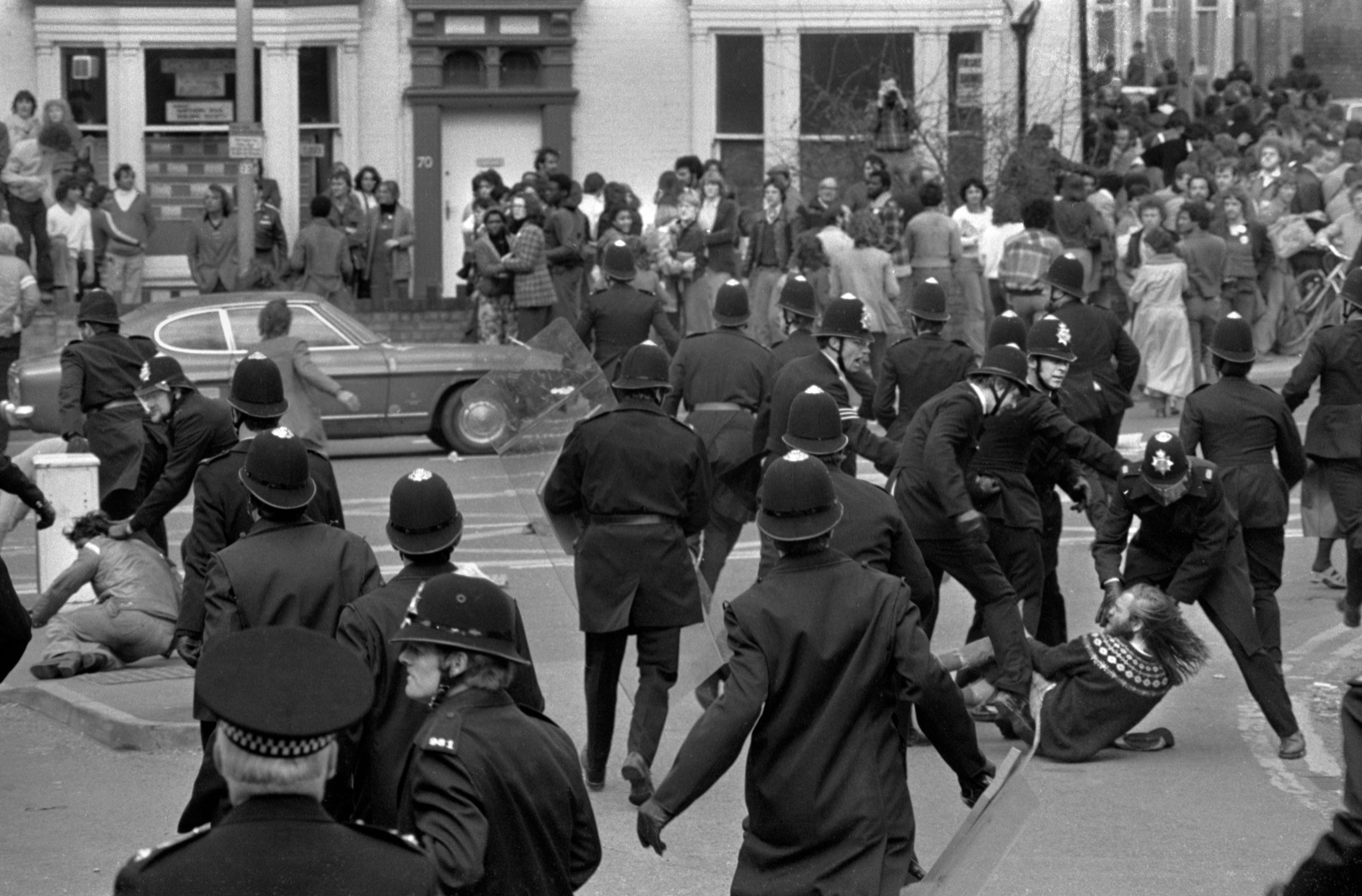This article was first published in Index on Censorship volume 32, issue 2 in 2003.
My departure early in the 1960s from Leicester, where I was born, more or less coincided with the beginning of a process of transformation that changed the city from a small town in the East Midlands grown complacent on its long prosperity to the vibrant Asian capital of Britain. In the process, it was to be physically brutalised by overzealous developers and, for a time, to suffer the reputation of the most racist city in the UK.
When I returned for an extended stay in the 1980s, the landscape of my memory had been swept away; the house where I grew up was now the city’s leading sari emporium. In repeated visits to family and friends over the past decade, I have had to relearn the city, try to fathom the complex economic, social and ethnic geography that has today earned it the title of ‘beacon city’, a place others look to for lessons in racial harmony and pointers to the achievement of that elusive target ‘cultural cohesion’, a newtake on what we once called ‘multiculturalism’.
But all that was a long way in the future in the year of my birth, 1938. Let me remember. In 1801, the population of Leicester was a modest 17,000; by 1901 it had grown to 212,489. They came for jobs from all over the UK and Ireland to work in the thriving hosiery, knitwear and boot and shoe factories, and the engineering works that provided the machines for these industries on which Leicester’s wealth was built. They lived in spreading acres of terraced houses thrown up in the latter part of the century to accommodate them.
Out of Africa
But, to all intents and purposes, Leicester remained a provincial market town, its medieval street plan and many of its timber-frame houses more or less intact. Despite the Victorian incursion with its factories, villas and teeming streets of workers’ housing, it was not a creation of the Industrial Revolution. Nor was it dependent on a single heavy industry and vulnerable to the vagaries of recession.
The population grew only another 60,000 or so in the following century. Most of the new arrivals came in the past 50 years, many of them from Africa. Their arrival in this provincial town brought changes more lasting and profound than anything since the Romans.
The town I walked with my schoolmaster grandfather was the ancient town of the Romans, with medieval streets and buildings dating from the time of the Crusades. We would stroll from the Castle Gardens at the foot of the remains of the castle by the river to the timbered Guildhall, the houses and almshouses built by city merchants, narrow streets with huddled shops smelling of tobacco and liquorice. These led, finally, into the Victorian facades of department stores and gents’ outfitters — and, of course, the vast (or so it seemed then) Leicester Co-operative Society store that dominated the high street of the modern town.
The second richest city in the Empire
Today, most of the old town has gone. The winding streets have been swept away in doubtless necessary slum clearance; much more has been sacrificed to a 1960s orgy of road-building. The Magazine stands marooned between the lanes of an urban freeway, accessible only by underpass; the castle, its gardens and the monuments of my childhood are cut off by swirling motorways and elevated roads. They have become a ‘heritage park’, no longer a living part of the city, a backwater for tourists and a throughway for students at De Montfort University. The murky waters of the Soar have been cleaned up and offer a riverside walk and, so the brochure tells me, a unique variety of river flora and fauna. Leicester is the UK’s first ecological city and is doing its best with what is left, but the destruction of the 1960s razed more than just slums. It is too late now for the once shabby but characterful seventeenth- and eighteenth-century city-centre facades, replaced with bland, anonymous reconstructions in the 1960s and 70s.
In 1936, Leicester, I was told, was the second richest city in the Empire; by 1953, it could still claim the distinction of having the second highest per capita income of any city in Europe. We grew up being told by my banker father we should be proud to live in such a city. But it didn’t translate into anything we wanted to do. Joe Orton, a local boy, said it was the most boring city in England and got away as fast as fame would carry him; JB Priestley, on a brief visit, stayed only long enough to remark that there were many worse places in which he’d rather stay. We agreed with them: it was a cultural wilderness, the result, perhaps, of the inward-looking nonconformist temperance spirit that had ruled the city council for decades and lingered still. The city fathers of the 1950s had no more time for culture entertainment than they were to show for architectural heritage. The last three commercial theatres — the Theatre Royal, the Opera House and finally the Palace of Varieties — closed, depriving us of pantomime, the Royal Ballet and other visiting delights. It was long after my day, in 1973,that the Haymarket Theatre opened and restored Leicester to the theatre circuit. We had music in De Montfort Hall, named for a long-dead earl; swimming in the open-air Lido; expeditions to the countryside, and long months spent vegetating in Lincolnshire with our grandparents. Our school was the best the city had to offer — but it was dull, provincial, and we longed to escape.
Which I did, in 1957, to university. And only then did I find out that Leicester is not what you see; at least not what I had seen. For all its complacency, Leicester had another side, invisible but discovered with shock when I delivered Christmas post in the vacations. The mean streets of working-class housing, by now down at heel and many still without bathrooms or inside lavatories, crowding up with the factories to the iron railings of our own house were familiar enough. But they hid much worse. Slums that could have come out of Dickens.
The Asian transformation
When I returned, the transformation of these places was even more dramatic than the loss of the city landscape I had once known. What I wandered through seemed nothing less than a small miracle. With the help of local council grants, whole neighbourhoods had been regenerated, houses as well as factories. Grey, depressing streets of mouldering Victorian housing had burst forth in candy colours and were once again thriving local communities — of Asians. Corner shops sold food and spices from India alongside the stock-in-trade of any neighbourhood store; the Leicester Mercury rubbed pages with publications in Gujarati and Punjabi; colourful bilingual books and wall posters for children displayed the alphabet and numbers in several languages.
It was the same with the factories and inner-city churches. Mills where the looms had long fallen silent were back in business, with the names of their new Asian owners superimposed on the ghostly letters of former household names; others had been divided into a myriad of small manufacturing units and workshops for Asian enterprise. Churches, nonconformist meeting houses, even in one case an old factory site, had become temples and mosques serving the neighbourhood.
The same was true of other old inner-city housing areas that had escaped demolition in the nick of time and had been rescued by the arrival of Asians from East Africa. The brand new Sikh gurdwara built on the site of Holy Bones, disappeared site of my ancient city, summed things up: not an appropriation, but a restoration of the city to itself. Economically and socially, the migrations of the late 1960s and early 70s — largely of Gujaratis fleeing ‘Africanisation’ in Kenya, Uganda and most recently Malawi — had, it seemed to me, saved a dying city. Along the Belgrave Road, for instance, the neglected shops of the old city centre were now Leicester’s ‘Golden Mile’, a glittering strip of shops dominated by jewellers and goldsmiths. Asians from all over the UK come here for their wedding finery, I was assured, rather than make the trip to Bombay. Diwali brings huge crowds into the area to celebrate the Hindu festival of light when this part of the city is lit up with a million lights and the explosion of fireworks. The biggest celebration outside India, it brings people into this once enclosed city. Leicester is no longer the self-regarding, inward-looking place it was, but looking out and welcoming a wider world.
Leicester is no stranger to migration. As Cynthia Brown of Leicester University’s Living History programme points out, people have been coming here since early in the nineteenth century. Then it was in pursuit of work; latterly, that went hand in hand with flight from war and persecution. Many, like the Poles who had fought in World War II and now found themselves unwelcome back in Communist Poland, settled in Leicester after the war; the late 40s saw the arrival of immigrants from the Caribbean plus the first Asians.
The flatness of the city
In 1951, the Asian population was just 624. Migration was hastened by the Commonwealth and Immigration Act of 1962: fuelled by people anxious to pre-empt its more restrictive conditions, migration had risen by 1961 to 4,624. They settled in the older inner-city areas, where cheap housing was available in the wake of the departure of English residents offered the chance to escape the decay by moving to council estates around the city. It was this early settlement that acted as the magnet, drawing dramatically increased immigration from Africa. Only a decade later, the arrival of Asians, largely Gujarati from Kenya, had swelled Leicester’s Asian population to 20,190. Despite warnings by Leicester City Council printed in Ugandan papers and inflammatory headlines speaking of disaster in the influential Leicester Mercury, it was inevitable that a ready-made community of their own kind and Leicester’s reputation as a ‘friendly’ city would draw the majority of Idi Amin’s Asian refugees to the city. The appeal of friends, family and their own community, as well as the promise of jobs, increasingly in Gujarati-owned enterprises, were not the only reasons, it seems. ‘I travelled all over the UK,’ says one African Asian, ‘and I made up my mind if I could choose anywhere I could come that I would settle in Leicester . . .I particularly liked Leicester . . . I was attracted to the flatness of the city.’
Of the 30,000 Asians expelled from Uganda in 1972, 6,000 came to the city. By 1981, the New Commonwealth population was 59,709 in a population of something over 250,000. The arrival of the new settlers in the ’70scoincided with Leicester’s first serious economic downturn. The city’s staple manufactures were being replaced by cheaper goods from abroad: factories were in decline and closing; unemployment was rising. Resentment among the white population burst into open racism and discrimination, at the workplace as well as in the streets. Bolstered by Enoch Powell’s dire warnings of the dangers of unbridled immigration, the National Front targeted Leicester and inserted itself into local politics. In 1976, it won 18 per cent of the vote in local elections; in 1979, in a climate of racial hostility fostered by the NF, Leicester witnessed one of worst racial confrontations in the country. Shocked and shamed out of complacency, it actively began to work at escaping the opprobrium of being labelled the UK’s most racist city.
Why riot when they had money?
Twenty years on, hard work, dedication and commitment from all the communities have ensured that, unlike Oldham, Burnley, Bradford, Southall, Toxteth, Brixton and other places with high immigrant populations, Leicester has not exploded again. A lot of money has been funnelled to minority community projects. Not always the answer, but as Leicester race relations policy officer Paul Winstone said with a certain realism: ‘Leicester City Council poured millions of pounds into ethnic groups. Almost every group could get something like £50,000 more or less just by asking. It wasn’t open bribery, but it most certainly was bribery — and it worked. Why should the leaders riot when they had money and an office?
‘In retrospect, Winstone describes the 1970s as the years of conflict, the 80s as the bribery years and the 90s as the decade of consolidation. But there is more to it than that. Asked why Leicester has become something of a model multiracial city, why, given that the minority population is now around 38 per cent and forecast to become the first majority ethnic community in the UK within the present decade, it doesn’t explode in racial violence, Asians themselves have another explanation. Above all, they point to the fact that they came not from India or Pakistan but from Africa, where they had occupied a privileged position as professionals, businessmen and entrepreneurs. They explode the myth still current in many places that they came with their pockets stuffed with money, but point out that they knew how to do things, did not rely on the local authority for housing or jobs but bought modest properties and eventually built businesses again from scratch. They were not like the uneducated communities of Bangladeshis or funda-mentalist Pakistanis who settled in other places.
Something else too, they say: ‘Remember, this was our second migration. In Africa we already knew what it was to be an unloved but tolerated minority. We knew how to keep our heads down, blend in and get on with people. We’d learned all that before we came here.’
The next generation
Sitting in a local pub, once a down-and-out watering hole but now Asian-owned, bright and cheery, I am struck at the convivial mix of people— Hindus and Muslims, Gujaratis, Sikhs from the Punjab, a few white Englishmen. I am struck by the lack of tension. Are there really no sectarian problems in the city? Jay, a Gujarati from Uganda, explains: ‘Most of us African Asians had never seen India. Unlike the people who came from the subcontinent, its politics and its religious hatreds were nothing to do with us, and so we didn’t carry all that baggage and perpetuate the old quarrels when we got here. The common experience of coming from Africa keeps us close; that is stronger than any religious divide.’ And that, he concludes, is something else that keeps his city, Leicester, from the sectarian extremism that divides other communities.
But this mixture of races and religions is rare. Again, Leicester is not what you see when you meet and talk to the dedicated people who work to bring communities together. The city is as segregated and zoned as it ever was in the days of the old working-class and middle-class divide. That it is largely self-segregated raises the question of how these parallel lives will settle down in the long run when the white English are in a minority, as they already are in most of the city’s schools. Maybe it’s only the next generation, now in the schools, who can answer the question. As one Asian boy put it to me: ‘If there are as many of me as there are of you, we don’t have to be afraid of anything, do we?’
Meanwhile, as people in the city admit, there are challenges to be met. Asians will say they are not yet strongly enough represented in the upper echelons of local government and industry, despite the presence of a growing number of local councillors from the minority communities. And the mix of poverty and ethnicity on local sink estates is creating tensions between black and white not evident in the city itself.
But, more than anything else, representatives on both sides of the ethnic divide fear the import of religious and political extremism from outside. The Hindu nationalist fundamentalist BJP government in India keeps close contacts in the city; following the outbreak of sectarian violence in Gujarat last year, they have been keen to put their version of events to the Gujarati community in Leicester. In much the same way, the Muslims of Leicester are disturbed by the ongoing trial in the city of alleged al-Qaida suspects. They feel a threat from the identification in the media and elsewhere of ‘terrorism’ and Islam. They have become introspective and assertive at the same time, demonstrating a sense of insecurity in a more aggressive assertion of their religion.
But all of this, I am assured more than once, is manageable as long as the city remains aware of it and is sensitive to its handling. There is optimism and a justifiable pride in Leicester’s record. ‘There are things to be done, but compared to other places we are doing well. And that’s official: it said so in the Cantle report that came out after the riots in Oldham and Burnley in 2001.’





